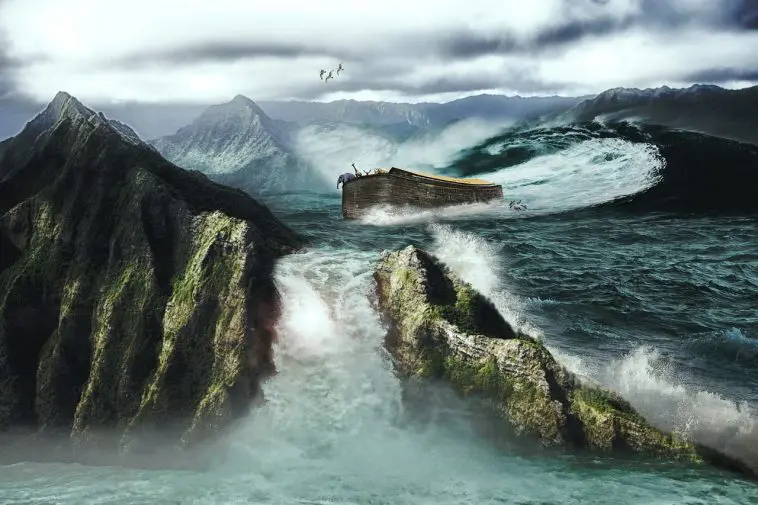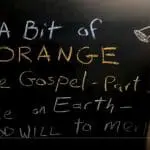Q: Couldn’t the Genesis flood have been a local or regional flood? The word erets (earth) in Hebrew, which is used in the flood account, doesn’t necessarily refer to the entire planet. It can mean just a land or region.
A: It is true that erets often refers to dirt or land more generally or to a nation or region. However, the case for a global flood in Genesis does not rest on erets meaning the whole planet. The meaning depends on the context in which it is used. There are multiple aspects of the biblical account that show us that the Genesis flood was global.
The Flood Killed All Terrestrial Life
The text of Genesis clearly states that all humans and all air-breathing, land-dwelling animals were killed in the flood, except for those on the ark. While some have suggested that this was a regional flood intended only to kill all humans, so while it was anthropologically universal, it was not global. Yet the biblical text clearly states that it also destroyed all terrestrial animals, not just humans. A regional flood that was only anthropologically universal does not fit the description given in Scripture.
And the LORD said, I will destroy man whom I have created from the face of the earth; both man, and beast, and the creeping thing, and the fowls of the air; for it repenteth me that I have made them. (Genesis 6:7)
And all flesh died that moved upon the earth, both of fowl, and of cattle, and of beast, and of every creeping thing that creepeth upon the earth, and every man: All in whose nostrils was the breath of life, of all that was in the dry land, died. And every living substance was destroyed which was upon the face of the ground, both man, and cattle, and the creeping things, and the fowl of the heaven; and they were destroyed from the earth: and Noah only remained alive, and they that were with him in the ark. (Genesis 7:21–23)
It is difficult to imagine how a local or regional flood could kill all terrestrial life. Surely animals would have lived outside the region affected by the flood. In fact, it is difficult to explain how all humans could be killed in a local or regional flood, even if they all lived in one small area.
While local floods can indeed be very deadly, they don’t kill everyone in the affected region. There are always survivors who cling to floating objects, climb to higher ground, or simply were not in the flood zone at the time. The universal destruction of all animals and humans in the flood supports a global extent.
A Limited Flood Does Not Require an Ark
Another objection against a local flood is that it makes the construction of an ark unnecessary.
If the flood would cover only a certain region, then there was no need for Noah’s family to spend so much effort building a boat or taking animals with them. There would be animals living outside the flood zone, so they would not need to be preserved. Noah and his family could simply move outside the flooded area.
God would know where to send them. This is what God did with Lot’s family when He sent judgment on Sodom and Gomorrah (Genesis 19). He didn’t tell them to build a bomb shelter and bring all the animals with them to keep them alive. He moved them out of the affected area.
The fact that God instructed Noah and his family to build an ark and take every kind of terrestrial animal with them only makes sense if this was a global flood and a boat was the only means of survival.
God also states directly that the purpose of the ark was to keep the people and animals alive.
And, behold, I, even I, do bring a flood of waters upon the earth, to destroy all flesh, wherein is the breath of life, from under heaven; and every thing that is in the earth shall die. But with thee will I establish my covenant; and thou shalt come into the ark, thou, and thy sons, and thy wife, and thy sons’ wives with thee. And of every living thing of all flesh, two of every sort shalt thou bring into the ark, to keep them alive with thee; they shall be male and female. Of fowls after their kind, and of cattle after their kind, of every creeping thing of the earth after his kind, two of every sort shall come unto thee, to keep them alive. (Genesis 6:17–20)
Local Floods Do Not Cover Mountains
The book of Genesis records that the water covered the mountains and high hills. This can only happen in a global flood.
And the waters prevailed exceedingly upon the earth; and all the high hills, that were under the whole heaven, were covered. Fifteen cubits upward did the waters prevail; and the mountains were covered. (Genesis 7:19–20)
Even if we discount the universal language that says all the high hills under the whole heaven were covered, a local or regional flood cannot cover mountains, even in a single region. Water flows downhill. In order to flood a mountain, it is necessary to flood the whole planet. Thus, the description of mountains being covered with water tells us this was a global flood. One could argue that Genesis is wrong, but it is unreasonable to suggest that it doesn’t intend to teach a global flood.
Local Floods Do Not Remain Flooded for Months
Genesis gives us a timeline for the flood. Contrary to popular belief, the flood did not last a mere 40 days. The flood began on the 17th day of the 2nd month in the 600th year of Noah’s life (Genesis 7:11). There were 40 days of rain, but we are also told that the waters prevailed upon the earth for 150 days (Genesis 7:24). After the 150 days, the waters began to go down. The ark ran aground on the 17th day of the 7th month, some 5 months after the flood began (Genesis 8:4). Nearly 2½ months later, as the waters gradually diminished, the tops of the mountains were finally visible.
And the waters decreased continually until the tenth month: in the tenth month, on the first day of the month, were the tops of the mountains seen. (Genesis 8:5)
Genesis records that it was 7½ months from the beginning of the flood until the tops of the mountains could be seen. The people and animals spent more than a year in the ark before the ground was dry enough to disembark (Genesis 8:13).
How does a local flood not only cover the mountains with water but also hold that water in place for months? This is simply not possible, naturally speaking. To match the description in the text, a local flood would necessitate some sort of supernatural wall to hold the flood waters in just that region so they could rise high enough to cover the mountains and remain there for months.
A global flood is the more reasonable explanation for water covering the mountains for that length of time, and it fits with the rest of the account. This is yet another aspect of the story that requires a global extent of the flood. It’s not just about the usage of a word or two. It’s the entire narrative.
The Ark Landed in the Mountains
The Genesis account states that the ark landed in the mountains of Ararat (Genesis 8:4). While we do not know for sure that the ark landed on Mount Ararat specifically, it was in a mountainous region. The ark ran aground as the water went down, and only later were other mountain peaks visible as the water continued to drain away.
In a local flood scenario, this landing spot is implausible. Local floods flow downhill. The ark would most likely be swept into low-lying areas far from the mountains, especially if it floated for a long time. How does a boat land in a mountainous region in a local flood? Local floods occur in valleys and plains, not in the mountains.
In a global flood scenario, the landing spot is much more reasonable. The ark would land on whatever nearby bit of land was available as the water level began to go down. The mountains were at sea level when the ark landed. Because it had already run aground, the ark was not washed down into the lower plains but remained in the mountains.
God Promised to Never Again Send Such a Flood
After the flood, God made a covenant with Noah’s family and with the animals that there would never again be such a flood on the earth to destroy all life.
And God spake unto Noah, and to his sons with him, saying, And I, behold, I establish my covenant with you, and with your seed after you; And with every living creature that is with you, of the fowl, of the cattle, and of every beast of the earth with you; from all that go out of the ark, to every beast of the earth. And I will establish my covenant with you; neither shall all flesh be cut off any more by the waters of a flood; neither shall there any more be a flood to destroy the earth. (Genesis 9:8–11)
Because this promise was given to both humans and animals, this indicates again that the flood was universally destructive to both humans and animals. Only those on the ark survived.
If this covenant refers to a global flood that killed all terrestrial life and which will never occur again, then God has kept His promise. On the other hand, if the Genesis flood was limited to just a land or region, then we have a theological problem. There have been many local and regional floods since the time of Noah. Did God fail to keep His promise? This would be a serious accusation against God’s character.
The Rest of the Bible Treats the Flood as Historical and Universal
There are numerous allusions to Noah’s flood throughout Scripture, including in the New Testament. The rest of the Bible unanimously treats the Genesis flood as historical. Hebrews 11, known as the Hall of Faith, lists Noah as a real person who prepared an ark to save his household because of his faith. Second Peter alludes to the flood in chapters 2 and 3 as an example of the gravity of God’s judgment and the certainty of God’s coming judgment of the earth.
Significant theology rests upon the universality of the Genesis flood. For example, Jesus spoke of His second coming as being like the flood of Noah’s day. It will be a sudden and universal event, with no escape for those who have rejected Christ.
But as the days of Noe were, so shall also the coming of the Son of man be. For as in the days that were before the flood they were eating and drinking, marrying and giving in marriage, until the day that Noe entered into the ark, And knew not until the flood came, and took them all away; so shall also the coming of the Son of man be. (Matthew 24:37–39)
First Peter 3 speaks of the flood as a picture of salvation in which eight people were saved through water just as Christians go through baptism in water when they are saved. The parallels here are profound. Just as salvation from the flood came only by being in the ark, so only those who are in Christ can be saved from hell. All others will be lost.
If the flood were not a universal event, that fact would undermine the theology built on this premise in Scripture. If someone could survive Noah’s flood outside the ark, it would suggest there might be a way of salvation outside Jesus.
Conclusion
It is important that we properly interpret Scripture in its context. The account of the flood in Genesis shows clearly, in multiple ways, that it was a global event. The text cannot be reconciled with a local or regional flood.
Though some people have argued that certain words in the flood account are not always used in a universal sense, the argument for a global flood has never depended solely on those words. The description of what happened does not fit a local flood.
- A local flood cannot cover the mountains and keep them inundated for months or kill all the people and animals on the planet.
- A local flood cannot land the ark in the mountains.
- An ark would not be needed at all for a local flood.
- Since God promised never to send another flood like the Genesis flood, if the flood was only local, that would make God a liar.
These are major, independent reasons to affirm a global flood just from the Scriptures, even without looking at the scientific and historical evidence that supports a global flood. Only a global flood can make sense of all the aspects of the Genesis account and the way the flood is referenced in the rest of Scripture.
This article first appeared in Creation Matters Vol. 29 No. 2, Spring 2024. Reprinted by permission.







